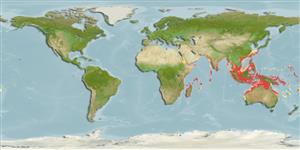Environment: milieu / climate zone / depth range / distribution range
Ecology
Marine; brackish; demersal; amphidromous (Ref. 51243); depth range 10 - 100 m (Ref. 12260). Tropical; 30°N - 30°S
Indo-West Pacific: from India to Papua New Guinea; north to Japan; south to Australia,
Length at first maturity / Size / Weight / Age
Maturity: Lm 9.4 range ? - ? cm
Max length : 23.0 cm TL male/unsexed; (Ref. 12260); common length : 15.0 cm TL male/unsexed; (Ref. 5450); max. reported age: 2.30 years (Ref. 4544)
Dorsal spines (total): 8; Dorsal soft rays (total): 16; Anal spines: 3; Anal soft rays: 14; Vertebrae: 24. This species of the Leiognathus splendens complex is distinguished by the following characters: no scales on cheek; anterior dorsolateral body surface almost completely scaled without a semicircular naked area on nape; lower margin of inner preopercular ridge is smooth or weakly serrated (including the neotype); interspace of pelvic keels without scales; second spines of dorsal and anal fins are robust (width of second spines of dorsal and anal fins 0.87-1.6% of SL and 0.76-1.7% of SL, respectively); a jet black blotch on spinous dorsal fin (Ref. 75583).
This schooling species inhabits coastal waters. It feeds on fish, crustaceans, foraminiferans, and bivalves (Ref. 5213). The annotated bibliography of Leiognathidae by Pauly and Wade-Pauly (Ref. 4961) includes 172 references pertaining explicitly to Leiognathus splendens.
Lipid stored in muscles, liver and intestine decreased during gonadal maturation and following spawning (Ref. 3655).
Kimura, S., T. Ito, T. Peristiwady, Y. Iwatsuki, T. Yoshino and P.N. Dunlap, 2005. The Leiognathus splendens complex (Perciformes: Leignothidae) with the description of a new species, Leiognathus kupanensis kimura and Peristiwady. Ichthyol. Res. 52 (3):275-291. (Ref. 75583)
IUCN Red List Status (Ref. 130435: Version 2024-2)
Human uses
Fisheries: commercial
Tools
Special reports
Download XML
Internet sources
Estimates based on models
Preferred temperature (Ref.
123201): 24.8 - 29.1, mean 28.1 °C (based on 1680 cells).
Phylogenetic diversity index (Ref.
82804): PD
50 = 0.5625 [Uniqueness, from 0.5 = low to 2.0 = high].
Bayesian length-weight: a=0.01995 (0.01578 - 0.02523), b=2.96 (2.90 - 3.02), in cm total length, based on LWR estimates for this species (Ref.
93245).
Trophic level (Ref.
69278): 2.9 ±0.38 se; based on food items.
Generation time: 1.2 (1.0 - 1.4) years. Estimated as median ln(3)/K based on 22
growth studies.
Resilience (Ref.
120179): High, minimum population doubling time less than 15 months (K=0.33-1.60; tm=1; tmax=2.3).
Fishing Vulnerability (Ref.
59153): Low vulnerability (15 of 100).
Nutrients (Ref.
124155): Calcium = 301 [127, 1,001] mg/100g; Iron = 1.94 [0.82, 4.73] mg/100g; Protein = 18.3 [16.3, 20.6] %; Omega3 = 0.231 [0.128, 0.423] g/100g; Selenium = 125 [48, 357] μg/100g; VitaminA = 4.78 [0.90, 27.87] μg/100g; Zinc = 2.33 [1.09, 4.14] mg/100g (wet weight); based on
nutrient studies.
